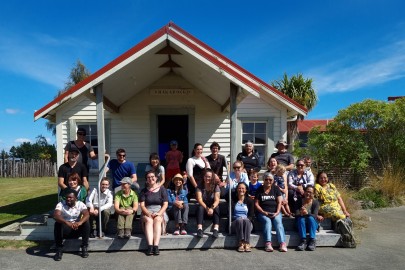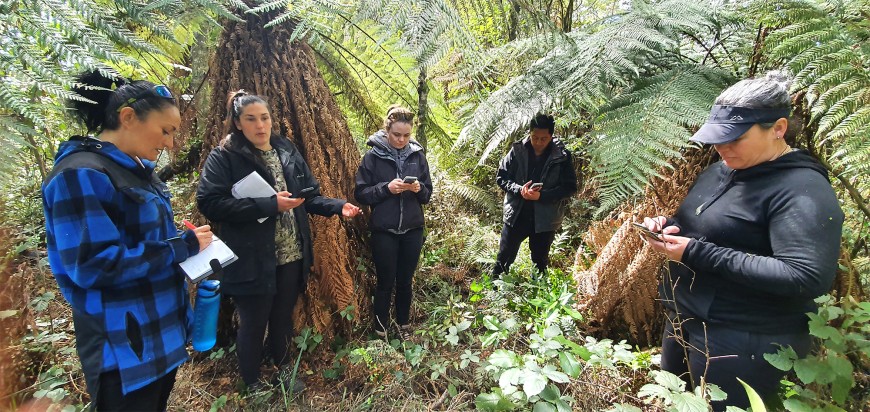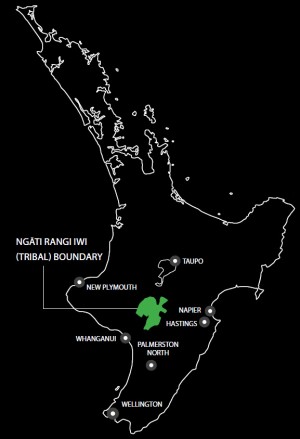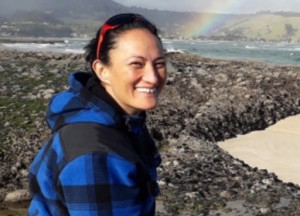
Ngā Mōkai Marae, Karioi. Outside the Whakarongo wharenui, the whānau who attended the tool release and trial.
A new paper published in Pacific Conservation Biology, ‘Me ora te Ngāhere: visioning forest health through an Indigenous biocultural lens’ presents the work of former Manaaki Whenua researcher and current Waikato University PhD student Kiri Reihana (Ngāpuhi, Te Rarawa, Ngāi Tūhoe, Whakatōhea). Kiri worked with Ngāti Rangi (a central North Island iwi) to create an indigenous framework that captures the state of biodiversity and environment that is informative and trusted by their communities.
Kiri’s research was co-authored by Manaaki Whenua Kaihautū Māori Impact Leaders Dr Phil Lyver (Ngāti Toarangatira ki Wairau) and Nikki Harcourt (Ngāti Maniapoto) as well as senior researchers Dr Andrew Gormley and John Innes, Kairangahau Māori Mahuru Wilcox (Ngāti Awa, Ngāti Ranginui), Megan Younger (Ngā Waihua o Paerangi Trust) and Morgan Cox (Kiwis for Kiwi Trust). The researchers explored developing a biocultural monitoring tool – in the form of an app – based on Māori knowledge to inform Ngāti Rangi about the health of separate, but ecologically similar forests within the tribal estate.
This was achieved through a series of noho taiao (community workshops) and interviews to collect the values that expressed a Ngāti Rangi world view to measure the health of the forest. Gradients and indicators were developed to apply a measure of ngahere health and trialled in three forests to create a group understanding.

Kiri (left) undertaking trial app tests with local kaimahi and team leader / co-author Megan Younger, at Mangaehuehu Reserve, Ohakune.
Kiri says a traditional practice of walking in complete silence to an allocated site, (such as the forest lake), to enable deep connection and listen to the voice of the forest, was revived from the noho taiao.

Tribal territory of Ngāti Rangi and the three forest monitoring sites (Makatote, Pōkākā and Old Coach Road), North Island, Aotearoa New Zealand.
“You can smell in a dry year the pirau (rot) of the forest because the moss is crying, because there is no moisture in there. That is the indicator,” said Che Wilson (Ngāti Rangi) during one of these sessions.
“It was amazing to see people who had hunted in the ngahere their whole lives have a renewed appreciation for their environment,” says Kiri.
“They took the time to stop and connect with the forest, and realised they were returning manaakitanga to the ngahere through things like pest eradication programmes.”
Kiri says the monitoring supported the Ngāti Rangi connection to place and cultural heritage through taking time to connect with their forests.
“By its nature, we acknowledge our biocultural monitoring tool, or app, is a living process that will evolve as the local practitioners refine and adapt it for their specific purpose and future use.”
Kiri also says future research needs to have a focus on building capacity for mana whenua to undertake these kinds of projects.
“We also need to look to the future and provide career pathways for rangatahi into science and environmental work, internships and apprenticeships to embed this mahi and knowledge for future generations.”

